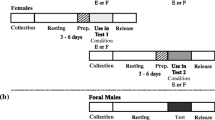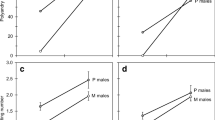Abstract
In many animal species, male and female interests often differ when it comes to decisions over mating and fertilization. However, it is intrinsically difficult to determine the degree to which males and females exert control over the various processes that determine the outcome of reproductive interactions, and thus to predict how such conflicts will be resolved. For example, in species where sperm are transferred to females via a spermatophore or other external sperm packaging device, it is unclear which sex determines subsequent sperm transfer dynamics to the female reproductive tract. To address this question, we used a reciprocal cross experimental design in a bushcricket species (Poecilimon veluchianus) comprising two subspecies differing in the dynamics of sperm transfer. The reciprocal crosses show that in these bushcrickets the timing of sperm transfer in inter-subspecies crosses closely resemble those typical of the subspecies of the male partner, indicating that it is the properties of the spermatophore rather than its handling by the female that determine sperm transfer dynamics. There was neither a significant female influence nor any indication of an interaction between males and females with regard to the number of sperm transferred after a set interval. Our study suggests that males rather than females appear to control the timing of the insemination process in this species.

Similar content being viewed by others
References
Achmann R, Heller KG, Epplen JT (1992) Last–male sperm precedence in the bushcricket Poecilimon veluchianus (Orthoptera, Tettigonioidea) demonstrated by DNA fingerprinting. Mol Ecol 1:47–54
Arnqvist G, Rowe L (2002) Correlated evolution of male and female morphologies in water striders. Evolution 56:936–947
Arnqvist G, Rowe L (2005) Sexual conflict. Princeton University Press, Princeton
Bloch Qazi M, Hogdal L (2010) Hold on: females modulate sperm depletion from storage sites in the fly Drosophila melanogaster. J Insect Physiol 56:328–333
Eberhard WG (1996) Female control: sexual selection by cryptic female choice. Princeton University Press, Princeton
Heller K-G, Reinhold K (1993) A new subspecies of Poecilimon veluchianus Ramme, 1933 (Tettigonioidea, Phaneropteridae) from Greece. Articulata 8:23–29
Heller KG, Reinhold K (1994) Mating effort function of the spermatophore in the bushcricket Poecilimon veluchianus (Orthoptera, Phaneropteridae): support from a comparison of the mating behaviour of two subspecies. Biol J Linn Soc 53:153–163
Lehmann GUC, Lehmann AW (2009) Condition-dependent spermatophore size is correlated with male’s age in a bushcricket (Orthoptera: Phaneropteridae). Biol J Linn Soc 96:354–360
Parker GA (1979) Sexual selection and sexual conflict. In: Blum MS, Blum NB (eds) Sexual selection and reproductive competition in insects. Academic, New York, pp 123–123166
Parker GA (2006) Sexual conflict over mating and fertilization: an overview. Philos Trans R Soc B: Biol Sci 361:235–259
Perez-Staples D, Weldon C, Radhakrishnan P, Prenter J (2010) Control of copula duration and sperm storage by female Queensland fruit flies. J Insect Physiol 56:1755–1762
Pizzari T, Birkhead TR (2000) Female feral fowl eject sperm of subdominant males. Nature 405:787–789
Proctor HC (1998) Indirect sperm transfer in arthropods: behavioral and evolutionary trends. Annu Rev Entomol 43:153–174
Reinhold K (1994) Inheritance of body and testis size in the bushcricket Poecilimon veluchianus Ramme (Orthoptera; Tettigoniidae) examined by means of subspecies hybrids. Biol J Linn Soc 52:305–316
Reinhold K (1999) Paternal investment in Poecilimon veluchianus bushcrickets: beneficial effects of nuptial feeding on offspring viability. Behav Ecol Sociobiol 45:293–299
Reinhold K, Heller K-G (1993) The ultimate function of nuptial feeding in the bushcricket Poecilimon veluchianus (Orthoptera: Tettigoniidae: Phaneropterinae). Behav Ecol Sociobiol 32:55–60
Sakaluk S (1984) Male crickets feed females to ensure complete sperm transfer. Science 223:609–610
Sakaluk S, Eggert A (1996) Female control of sperm transfer and intraspecific variation in sperm precedence: antecedents to the evolution of a courtship food gift. Evolution 50:694–703
Simmons LW (1986) Female choice in the field cricket Gryllus bimaculatus. Anim Behav 34:1463–1470
Snook RR, Hosken DJ (2004) Sperm death and dumping in Drosophila. Nature 428:939–941
Tregenza T, Wedell N (2002) Polyandrous females avoid costs of inbreeding. Nature 415:71–73
Vahed K (1998) The function of nuptial feeding in insects: review of empirical studies. Biol Rev 73:43–78
Watanabe M, Sasaki N (2010) Pattern of sperm storage and migration in the reproductive tract of the swallowtail butterfly Papilio xuthus: cryptic female choice after second mating. Physiol Entomol 35:328–333
Acknowledgments
We thank Karin Reinhold for her help with the experiments and Leif Engqvist for his comments on the manuscript.
Author information
Authors and Affiliations
Corresponding author
Additional information
Rights and permissions
About this article
Cite this article
Reinhold, K., Ramm, S.A. Male control of sperm transfer dynamics in a spermatophore-donating bushcricket. Behav Ecol Sociobiol 67, 395–398 (2013). https://doi.org/10.1007/s00265-012-1459-4
Received:
Revised:
Accepted:
Published:
Issue Date:
DOI: https://doi.org/10.1007/s00265-012-1459-4




